Documentation of an incident in 1993 where Toronto Anti-Racist Action targeted Gary Schipper, a nazi organiser who ran a telephone hotline from his home. Taken from the Arm the Spirit site.


… back in 1993, Toronto Anti-Racist Action stated, in a flyer printed up and handed out prior to the now infamous June 11 action, that:
“Fascist groups in Toronto have escalated their use of violence and intimidation tactics. They are testing how much the community will let them get away with. Now that Anti-Racist Action and other groups have proven we can shut down their meeting and far outnumber them on the streets, they have resorted to more secret organizing tactics. But we aren’t going to let them carry out and escalate their violent activities. We have to respond to their terror.
On June 11, we will take the fight to them. We will demonstrate outside a Nazi centre of operation. Their ability to carry out hate crimes from the safety of these headquarters without their neighbour’s knowledge is what gives them the nerve to further terrorize Toronto communities and spread hate literature internationally.
In order to prevent Nazi attacks on our march, we are not divulging the location in advance. This action will be self-controlled and the safety of anti-racists will be our top priority. Please join us. We have learned from history that fascism doesn’t disappear by just wishing it away. It must be confronted by an overwhelming majority of people standing up and refusing to allow it to grow.
We can prevent fascism from taking root in this country, but we must act before it is too late.”

… what follows is a bit of the documentation/debate around this action, which saw ARA nicely deke out the Heritage Front by taking the fight not to (as was expected by the cops and nazis) Ernst Zundel’s bunker but rather to the home of Gary “the voice of the Heritage Front” Schipper… some damage was done, some displeasure was voiced and, later, some arrests were made…
Anti-Racist Mob Trashes Home
Toronto Star / June 12, 1993
A frenzied mob of more than 200 anti-racist demonstrators rampaged in east end Toronto last night, vandalizing the home of a well-known white supremacist as police watched
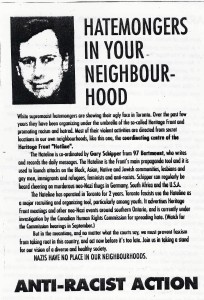
None of the screaming demonstrators was arrested after smoke bombs, rocks, paint, human excrement and even a child’s bicycle were thrown through the windows of the Bertmount Ave. home of Gary Schipper.
Schipper, who operates the Heritage Front Hotline, a white supremacist telephone information line, appeared shaken when he arrived at his rented house, south of Dundas St. E., east of Carlaw Ave., only moments after the throng left.
Demonstrators said he had been singled out because he is a “Nazi hatemonger.” The Heritage Front Hotline has been the target of complaints to the Ontario Human Rights Commission over the past several years.
“This doesn’t surprise me,” Schipper said as he grimly surveyed the smashed glass and spattered pink paint on his front porch.
“These anti-racists are terrorists. They are very violent people. I think they are people who should be feared.”
The demonstration was organized by Anti-Racist Action, and umbrella group of gays, lesbians, anarchists and the far left.
They massed in a downtown park, then hopped on to streetcars to Queen St. E. and Jones Ave. where they reassembled in another park for the three-block march to Schipper’s home.
Demonstrators handed out leaflets, accusing Schipper of promoting racism and hatred, to startled residents along the route. Many carried photos of Schipper’s face on sticks. Others stuck the photos into lawns and set them ablaze.

Horrified neighbours watched as masked youths repeatedly attacked the house, then raced back into the anonymity of the mob.
May recoiled in terror as smoke bombs and firecrackers exploded amid the chanting crowd.
“They’re acting like a bunch of 2-year-olds,” cursed Ronald Hobday, 62, who has lived on Bertmount Ave. for more than 40 years. “What a bloody charade, for crying out loud. And the police just stood there and did nothing.”
Hobday said Schipper, who moved into the quiet neighbourhood at six months ago, was a quiet person who never attracted attention to himself or his activities.
“We’ve never had a problem with the guy,” he said.
An enraged Wolfgang Droege, head of the Toronto-based white supremacist and neo-Nazi Heritage Front, stormed into the house and vowed revenge on the anti-fascist protestors.
“They’re cowards to target individuals like this,” Droege said. “From now on, if that’s how they want to play the game, that’s fine.”
One furious white supremacist held a black Anti-Racist Action banner high and lit it on fire, shouting “get the ARA.”

A police official told The Star that outnumbered officers didn’t intervene when the mob attacked Schipper’s home because they feared arrests might lead to more violence. About a dozen police were at the house.
“At least no one was hurt,” said Staff Sergeant Terry Adams.
Earler, white supremacists gathered outside the Carlton St. home of Ernst Zundel, which had been draped in plastic sheeting in anticipation of an attack that didn’t come.
Both police and Heritage Front officials said they anticipate more trouble in coming weeks.
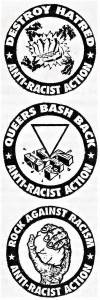
Anti-Racists Vent Anger On White Supremacist
Demonstrators Vandalize House While Outnumbered Police Look On
Globe And Mail/June 12, 1993
Anti-racist demonstrators marched on the home of a white supremacist in the city’s east end last night, hurling paint and excrement a the house and smashing ground-floor windows while a small number of police looked on.
As shocked neighbors emerged from their homes to watch, about 175 members of Anti-Racist Action (ARA), which has been mobilizing high school students and university students over the past year, converged on a house near Queen Street and Jones Avenue where tenant Gary Schipper says he operates an “information” hotline for the Heritage Front, a white supremacist group.
Chanting “Hey ho, Hey ho, Gary Schipper’s go to go,” and other slogans, the demonstrators linked arms in a circle while some members of the group, their faces covered with kerchiefs and hoods, shattered the doors and windows. Others threw several noisy, smoky firecrackers and paint bombs on the front lawn and at the house.
The leaders of the well-publicized demonstration, who refused to give their real names, were secretive about their intended destination as they met in a downtown park.
Metro Police officials tried to meet with the group before the march, but said organizers refused to do so.
The police and some reporters had expected the group to head for the home of Holocaust revisionist and publisher Ernst Zundel.
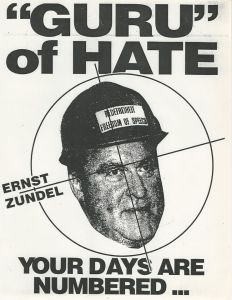
Staff Inspector Stan Shillington last night defended the police officers’ decision not to step in and stop the vandalism. He said the force had prepared for the demonstrators and had assigned officers to the address they believed to be the target, leaving only a few officers to follow the crowd.
Wen the crowd went to another location, the officers following them were “totally outnumbered,” he said. At the peak of the demonstration, fewer than half a dozen officers could be seen.
Staff Insp. Shillington said if the police officers had stepped in, the violence might have escalated and someone could have been injured.
Starting from a park at Sherbourne and Queen, the demonstrators marched briefly before boarding eastbound TTC cars. “ARA the better way,” quipped one demonstrator as members of the mostly young group crowded onto the cars.

The march organizers did not specify their destination until they had arrived at the house, handing out leaflets about Mr. Schipper and neo-nazi activities in Toronto.
Mr. Schipper told reporters he left his home shortly before the demonstrators arrived and returned after they left to survey the damage.
Accompanied by a group of young men, one wearing a Confederate flag bandana, Mr. Schipper complained that “anti-racists are very violent, much more violent than so-called racists … they’re very frustrated, confused people.”
He said he has been living at the house for five months, but had planned to move out at the end of June.

Wolfgang Droege, a spokesman for the Heritage Front, complained to the 12 officers present about their failure to arrest anyone on the spot.
Staff Insp. Shillington said last night, “We are anticipating arrests.”
Chris Hannah, who sat on the front steps of his home as the chanting demonstrators made their way to Mr. Schippers house, said he knew nothing of an neo-Nazi activities in the neighbourhood. “If it’s true, I don’t disagree with the anti-racist sentiments,” he said.
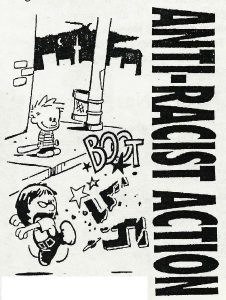
Anti-Racist Action:
To Community Groups
June 23, 1993
On Friday June 11, Anti-Racist Action marched through the South Riverdale community to expose, oppose and confront violent white supremacist organizing activity in that area. The demonstration targeted 97 Bertmount Avenue, a residence where Gary Schipper wrote and recorded the vile messages of the Heritage Front Hateline. The Hateline not only gives a forum for openly racist, anti-semitic and homophobic messages, it is also used as a promotion and recruitment tool for the Heritage Front and paramilitary organization Church of the Creator, groups that have a long record of hate-mongering, violence and intimidation.
During the demonstration, some anti-racist protestors struck back against Gary Schipper and the Heritage Front. Paint bombs and rocks were thrown at his residence and windows were broken. Although these acts of vandalism were not planned by ARA, our group allows people to express their anger against fascism and white supremacy as they see fit. We do not police anti-racists.

Violence, Anger and the Media
Since the demonstration, the media has made every effort to marginalize ARA. Echoing the Heritage Front, some reporters have described us as “anarchists, militant gays and lesbians, members of far left groups.” In this way they delegitimize the anger that is building in this city against fascist groups and racist, anti-Semitic and homophobic thugs in general.
We have been dismissed as unprincipled hooligans, when all the evidence shows that anti-racist protestors remained disciplined and focused during the demonstration, limiting property damage to Schipper’s address. Furthermore, ARA supporters who went door-to-door explaining our presence met with strong support from the majority of area residents. While many were understandably nervous about a large militant demonstration passing through their neighbourhood, most were far more horrified to learn of a nazi organizing in their backyards.

Some have accused ARA of “descending to the level of fascists.” We find it indecent, at best, to compare ARA’s restrained protest to the cowardly and brutal violence committed by Nazis recently:
- A five-on-one assault on a Black community activist in Toronto
- An arson attack on a residence for young women in Toronto
- An anti-Semitic attack on a man in Kitchener
- Five people hospitalized by nazis rampaging through the streets of Ottawa after a Heritage Front recruitment rally
- A Tamil man grabbed and beaten in Toronto by a nazi drunk and pumped-up after a Heritage Front rally earlier that evening
Where was the public outcry in response to these attacks? And the many others inspired by local fascists if not carried out by them? Where was the media? But when a white man’s windows are broken in an act of outrage against nazi terror, those young people are branded as criminals.

What Are Other Anti-Racist Activists Saying About June 11?
Media have diligently sought out anti-racist organizers and activists to publicly denounce ARA and the June 11 demonstration. So far, they have had little success. Even those who cannot endorse such an action for political reasons have gone out of their way to avoid condemning us:
- Dudley Laws of the Black Action Defense Committee called the action “extreme … but justified.”
- Bernie Farber of the Canadian Jewish Congress: “The problem is…the police and the attorney-general’s office have not been cooperating. They have not used legislation as a means to stop hate-mongering. Young people…understandably get very frustrated and wrongly take the law into their own hands. I really hold the people who are in a position of authority responsible at this point because they have chosen to do nothing [about hate crimes].”
- Martin Theriault of the Canadian Centre Against Racism and Prejudice: “Even though no one can support the vandalizing of a person’s house, we also have to understand that given the amount of pressure and vicious attacks by the neo-nazis, and the lack of law enforcement response to neo-nazis in the past, that we did have all the conditions necessary for the incident as Schipper’s house to occur.”

Different Strategies – One Anti-Racist Movement
We are learning from events in Europe and elsewhere that we need to use a variety of tactics in the fight against fascism. In Germany, the resurgence of the far-right has not been prevented even by laws against nazi organizing and propaganda much stronger than Canadian hate laws. Cops and the courts may sometimes slow down white supremacist activity, but we can’t depend on them alone – particularly when members of neo-nazi groups are employed by the military and police forces. European anti-fascists are also learning that millions may march in the streets against racist violence, but the murders and firebombings continue.
As a youth-oriented group ARA is developing its own particular strategies to fight grassroots racism. We’ve focused on education in high schools, both to empower those who are targeted by fascists and to prevent racist recruitment of young white students. We participate in anti-racist coalitions and help build mass demonstrations, and also organize militant and direct street action against local nazis.
Some anti-racist protestors were frightened at the June 11 demonstration. We sympathize! Because anti-fascist work is always dangerous, we prepare for possible attacks in any way we can, whether by developing defensive marshaling strategies, by carrying heavy picket signs to protect ourselves, or by keeping a march route secret. these tactics kept anti-racists safe on June 11, although close to 50 members of the Heritage Front and Church of the Creator were assembled a few block from our staring point.
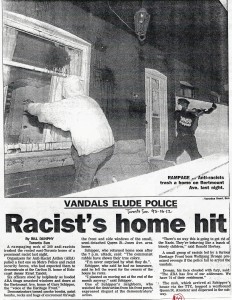
We have to be clear with ourselves that it is fascist goons and racist police that make anti-fascist work dangerous – not militant anti-racists! And the risks we take are worth it because we are seeing some results. While the Kitchener chapters of the Heritage Front holds meetings and displays propaganda in a downtown storefront, Toronto Front members can’t openly maintain an office space, their homes and offices have become their centres of operation. But after June 11, Droege and his partners in crime won’t feel so secure hiding in their homes, organizing for the “final solution”
As a single group in a broad anti-racist movement, Anti-Racist Action supports all efforts and strategies to say NO TO NAZIS, whenever and wherever the appear. In light of current efforts to divide the anti-racist movement over a few broken windows, we ask for your continued support.

Interview With A Member Of Anti-Racist Action
On June 11, 1993, Anti-Racist Action (ARA) in Toronto entered into a new phase of actions against neo-nazis in the city by taking the struggle against them to the realm of “nazi-doorsteps”. After a month of discussions, ARA embarked on a pro-active means of confronting the nazis by exposing them within neighbourhoods where they hide and organize. This new orientation represented a shift by ARA in that they would no pursue a strategy based solely on reacting against fascist organizing and violence. ARA decided to broaden its tactics as another step towards stopping the nazi- menace – in a concrete way – in Toronto. This action at the Nazi operational centre was organized during a period of covert fascist terror against people of colour – especially the Tamil community – and others. After June 11, various sectors and communities reacted to the ARA action and informally raised concerns about anti-fascist strategies and tactics. Ravi John from ARA addressed some of these issues in an interview with CKLN 88.1, a community-based radio station in Toronto.
On Friday, June 11, 1993, Anti-Racist Action organized a march to the home of neo-nazi propagandist Gary Schipper – the operational centre of Heritage Front “Hateline”. Since that demonstration, 4 anti-racists have been arrested. What were the charges under which the 4 were arrested and what are the bail conditions for their release?
The 4 anti-racists have been arrested on charges of mischief to property and disguising with the intention to commit an indictable offense. Other than that, I think one of them was charged with counselling to commit an indictable offense and one woman is charged with assaulting a police officer.
Are these charges quite serious for these ARA members?
I think it is quite serious in the sense that the police want to criminalize the anti-racists, and in the sense that they want to put them into the same category as neo-nazis, and show them as a somewhat criminal element in our society; which is not true.
I understand the bail conditions are pretty tough also…
The bail conditions include non-association with other ARA members and they are banned from any demos in the entire province of Ontario – no matter if they are anti-racist or not, and there is a curfew stuck on them – they have to be at home at 9 o’clock in the evening.

Let’s go back to the demo of June 11. What is the official position of ARA on the events at Schipper’s house?
The event, as such, was not isolated; we can’t isolate the event or the nature of the demo. What happened on June 11 was that ARA decided that we should take the anti-racist struggle, or the fight against neo-nazis, to their own territory, to their own operational centres. The home of Gary Schipper was targeted because anti-racists had been watching that place for some time and observing what kind of activities were going on there. The house was an operational centre, it was not just a home.
So, 300 people gathered in a community centre in Toronto, and we were very open about the fact that we were going to keep the destination of the demonstration a secret. Eventually, when we got closer to this operational centre, we distributed flyers and
stickers, and we started to put up stickers around the neighbourhood, and we gave Schipper’s photograph to the demonstrators, and so they knew that we were going to his place. The purpose was to expose that location to the community there – here nazis are carrying out their hate propaganda and also this is where they coordinate their activities. So, ARA was able to show the community that nazis can’t get away with these things – people are prepared to come to their doorstep and express their anger. This is quite opposite to what nazis have been doing; terrorizing people in a discreet manner.
During the demo, some anti-racists broke away from the crowd and they did some damage to the property. You have to understand that it was a very focused action – no other homes were damaged. You have to understand the context of what happened and the context of the times. There had been attacks against anti-racists in Ottawa, there had been two attacks against the Tamil community here – one person was killed and one is now partially paralysed. The had also been an attack in Kitchener against a Jewish shop owner. There had been an attack on Black community activists, and there was an arson attack on a young women’s hostel.
So, I think, in this context, some youth decided to express their legitimate anger. ARA’s position is, it is not for us to condemn or condone that. We have to understand why this happened, and so the burden does not lie with ARA, rather it lies with the neo-nazis; their activities have led to this type of situation. It is not our task to police our people. If some youth decide to do that sort of thing, our task is to protect them, because we understand their legitimate anger. I think ARA prevented a division among the ranks of anti-fascists and anti-racists.

The June 11 demonstration has sparked a huge media attack on ARA. Apart from the mainstream media, there have been some legitimate concerns raised by the community, one of which is that at that particular demonstration people went to it thinking that it was going to be peaceful. But on arriving there, things turned out differently. These people might be alienated from further ARA actions. How do you deal with that concern?
I think I have to make just one small clarification. We assembled at the community centre – that was peaceful. We had a small outside rally there – that was peaceful. We took streetcars to the operational centre – that was peaceful. Then we gathered in a small park – that was peaceful. We marched through the neighbourhood to Schipper’s house and that was peaceful. But ARA never tries to hide the fact that when it comes to confronting nazis there might be – there might be – some sort of action that does not fall into this category of so-called ‘peaceful demonstrations’. People are aware of that, and that is the tradition of ARA, and ARA was actually born with that tradition last year when the neo-nazis tried to march to the courthouse, but were chased away by anti-racists.

I can understand these concerns because people from various backgrounds and various levels of political understanding, who still want to oppose neo-nazis, they see these demonstrations as the ideal opportunity to express their anger, even in a symbolic
way. At the same time, you have to understand that we don’t want to divide the movement; we don’t want to see that a certain crowd just adheres to peaceful means and others adhere just to militancy. Both forms of action are complimentary to each other.
June 11 was just one demo. It is not the only strategic way of fighting nazis for ARA. For ARA it is a broadening of our tactics, but it is not the one strategic way of dealing with things.
We have to consider that ARA is not the only organization in this city which fights the nazis and takes the initiative in fighting racism. However as an organization, ARA can’t satisfy everyone. ARA has chosen the strategy of direct action against neo-nazis whenever possible. If others want to embark on different tactics, then we respect them and see them as valuable contributions to the overall struggle.

But the problem is, you know that an organization like ARA is a perfect target for agents provocateur, right? And if there isn’t internal discipline within the movement, then it’s an ideal opportunity for somebody from the outside to come and disrupt things, and it would reflect on ARA as an organization. I’m not saying that’s what happened at Schipper’s house, but in the future that could happen. Are there ways that you can prevent that from happening, as an organization?
At every demonstration we should have an assessment of the nature of the demonstration and what is the purpose of the demonstration. If the action of an individual or a group of people falls within the scope of ARA’s strategic aims, we don’t have sufficient reason to suspect anybody. Furthermore, the charge of agent provocateurs has traditionally been used against militant political activists, Yes, we are conscious about agent provocateurs; but the organization that plans and carries out political actions has a better chance to identify agents rather than outside political observers
At ARA events, people of colour are often on the front-line and knowing the historical background of how the police look at people of colour, and how they target them, the concern is that in an organization in which the majority are white, people of colour are being put in the front-lines during ARA actions.
I think we have to look at all the past actions of ARA, because I think this concern really came to the forefront after June 11. These concerns are legitimate and we can understand these concerns, and the problem is, okay, it is a fact that the majority of ARA members are white, so in that sense we can expect that the most militant members are going to be white, which may or may not be true; it is beside the point. In any actions which ARA has planned or has taken, we do not tell what position to take. We try to create a relatively safe space in demos, then participants decide where to position themselves.
ARA does not go and try to exclude people, so this might be one demonstration where the majority of the people who took a front-line stance were people of colour. But I don’t think this is true for all ARA demonstrations; because if anybody wants to take to the front-line and be strong and very militant, and can take the pressure not just from the neo-nazis but also from the police, they are welcomed. I think, in this sense, that most people of colour, because of their day-to-day repression and the discrimination they face, I think that they have that strength because that is their reality, and so if they decide they want to be in the front-line, I think we should allow that to happen. But the problem is, yes you are right, that they are the people who are going to be targeted. So, people who don’t want to be in the front-lines, their main responsibility is to protect these people.
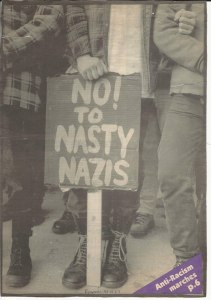
And that goes beyond the actual organization itself, to the community itself, lets say, people of colour who are not part of ARA. The ARA actions are creating an atmosphere where there is retaliation against communities of colour. Somebody walking down the street might be attacked by these neo-nazis just because of the colour of their skin. That brings us to the question of accountability to those communities of colour who are being affected by ARA actions, but whose opinion may not be listened to. How do you address that concern?
That is a legitimate concern and it is not a new one; it has been here in other social struggles also. I think, first of all, the anti-racist movement in the city is not responsible for actions of the neo-nazis. The neo-nazis are the people who are responsible for their own actions – that’s why we want them to be held accountable.
I am a refugee, and I was living with other refugees in a rooming house in Pickering (a city outside of Toronto – ed.) in 1989, and I was attacked by a skinhead, and that was just one year before the Heritage Front started – that is how I got a keen interest in these issues.
And now it is reported that there are over 500 hate crimes in Toronto, and most of the attacks are not even reported. So, anti- fascist actions might create a situation that when the nazis are cornered and when they get more and more defensive day-by-day, out of desperation they might take out their anger on a person of colour. But, at the same time, the violence of the nazis is not initiated by actions against them, and they are not motivated to go out and attack people of colour because there is an anti-racist presence in the streets. Rather, that is their ideology, that is what they spend their time preparing for. When they go out and attack a person of colour, it’s a matter of timing.
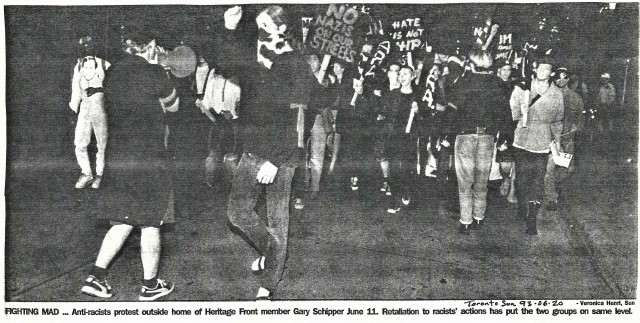
That is exactly what happened in Germany in 1988, when I was a refugee there. The neo-nazis were very marginal, mostly marginalized youth. The mainstream and the radical political community completely ignored them. The nazis organized very well and they were prepared when the Berlin Wall fell, and all the other social concerns unfolded, and they were prepared to go on the attack against people of colour. Despite the anti-racist presence there in Germany, the brunt of the attacks are against people of colour. But that does not mean that people of colour should not take part in defensive actions against nazis. Actually, the strongest anti-racist youth are Turkish youth because they are the people who are targeted. They are much more militant than all the radical political activists. Day-to-day they fight the nazis in the street because that is a matter of survival for them.
So, these things happen, we have to be aware of that, but at the same time we should not strategize the anti-racist struggle based on just this concern. We have to think of going beyond that and how to stop these people, because I don’t want to get involved in this struggle for the next 20 or 30 years just fighting neo-nazis. I don’t want to see society polarized. I want to see these people stopped in a concrete way, at least in their organizing capability. They should feel cornered and besieged and threatened for being neo-nazis. I don’t want to feel threatened for being a person of colour.

Is there a dialogue planned with the community? I think that part of the problem is that there is lack of communication and that concerns are raised and there is no dialogue between ARA and certain communities that have been organizing against racism in a more traditional sense.
Yes, to an extent. I don’t want to pretend that it is going smoothly. ARA has one crew of members that are devoted to the task of reaching out to other communities, but it has not happened through very constructive dialogue of what is the strategy for neo- nazis. I think it should come up within the struggle. We can’t just come up with a blueprint and go to the communities and say ‘this is the blueprint for fighting nazis -what do you think, what are your concerns?’ I think it will come up within the struggle. We saw that happening particularly after June 11. Before June 11, yes, we tried, through the outreach crew, to reach these communities and ask for their support, and people had concerns for some time, but after June 11, yes, people had a lot of concerns, and they raised these concerns. And we were able to get back to them with a very clear statement of what happened, and ask for their continued support.
At the same time, very positive things have happened. After the attacks against the Tamil community, a wide coalition was initiated by anti-racists and activists from the left political community. This was very positive and it give us ample opportunity to deal with these concerns in a very direct way. At the same time, we did not hear any reservations, in a concrete way, from any one of the communities.
I think that dialogue should happen because we don’t want to do something “for” them. And after all if we don’t address their concerns it doesn’t help our struggle in the long term. So I think that communication should be more comprehensive and it should be an ongoing thing, and I think that because of the anti-racist coalition in this city and because people are now aware of ARA better than before, there is some attention on ARA, and it can help us when we go to them and discuss these concerns.

One thing ARA has done effectively is to stop neo-nazi recruitment in high-schools. One problem with an organization that depends on direct action – and ARA is not the only one – is that we have the experience of other organizations especially directed towards youth who might join ARA as a first political act in their lives, and they really have lots of energy but little politicization. How much of that is a problem, and how are you trying to deal with it?
ARA has been somewhat successful in organizing high-school students who are being deliberately targeted by the Heritage Front. And most of these youths are white and, yes, it might be their first political involvement, and their first political engagement and political action might be being involved in ARA. Anti-Racist Action is something they can relate to, because this is a question within their own community, within their own society, within their own social level. It is something they can easily relate to: neo- nazis and fascists are targeting us and we are subject to their recruitment.

ARA has been able to attract these youth through various means, not just street-level political action, but through creating an anti-racist culture, through concerts and parties and making some social space for them. So, these people are attracted to ARA, and the way politicization happens is that it is not just what you can read in a textbook, I think people will be solidified and enlightened when they broaden their outlook from just focusing on anti-fascist work to other issues like police violence and institutionalized racism; by being involved in day-to-day actions. It might be going to a Rock Against Racism concert, it might be going to a symbolic demonstration where they can express their anger – most ARA demonstrations are that type of protest demonstration, not direct action type demonstrations. For example; four demonstrations against police violence which we organized with Black Action Defence Committee. There was a demonstration after gay people were attacked in Montreal, and we said that we will not allow that in our streets. There was a demonstration against Paul Fromm, a teacher who is also a neo-nazi.

These actions give space to young people to broaden their outlook. It is not just taking them to direct action. Within that process, I think people will get politicized, and honestly, some people might think ‘this is going to far, this is not what I want’, and they might keep some distance and come only to events where they feel they fit in.
I think that is the way we see things, because nobody has a blueprint that says what political action is, and it is during the anti-racist struggle, when people get into discussion and debate and when they exchange ideas with other organizations – those experiences lead to politicization. It is not a question of politicization first and then action – the two are complimentary to each other and are an ongoing thing.







Comments